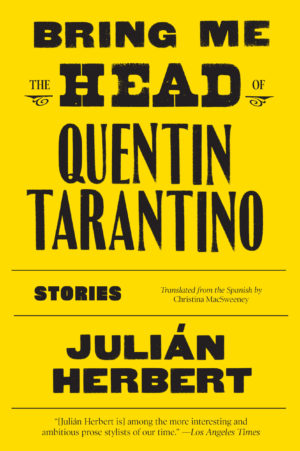Bring Me the Head of Quentin Tarantino
by Julián Herbert, translated by Christina MacSweeney
reviewed by Gabriel García Ochoa
Why read this review when you could be reading Julián Herbert’s Bring Me the Head of Quentin Tarantino instead? I don’t know. But in case my opening question has not yet convinced you, here follow some of the many reasons you should turn immediately to reading Herbert’s newly translated story collection.
Herbert’s second book to be translated into English by Christina MacSweeney, Bring Me the Head of Quentin Tarantino is a collection of nine short stories and a short novella. Herbert’s style is … transgressive? Unapologetic? Crass? Intellectual? Laugh-out-loud hilarious? Reflective? Highbrow, lowbrow, middlebrow? All these characteristics, packed into just 167 pages, make the book an absolute page turner.
In fact, the collection made me think that we should start using that idiom—“page-turner”—to mean two different things: a “forward turner,” with the traditional sense as used for a book that is engaging and engrossing, but also a “backward turner,” for when a text prompts reflection and we crave rereading it, or parts of it, to understand it better. Herbert’s book, Janus-like, maintains this thrilling mobility in both directions. Like those of Jorge Luis Borges, Herbert’s stories are part fiction, part essay, part poignant cultural commentary. Aesthetically, his writing evokes the titular filmmaker’s style in that it tends to be nonlinear, so over-the-top gory that it becomes camp, and quite funny.
A refreshing element of Herbert’s book, one I have not come across with such prominence in other contemporary Mexican fiction, is his varied representation of queer characters. Among these are a domestic, bickering gay couple in Berlin; Max, a Mexican bureaucrat living in Paris; Urko, a violent narco who inherits his uncle’s cartel; Capitán Aldana, a corrupt federal officer; and a washed-out, crack-addicted journalist who pretends to be the deceased Spanish author Marcial Lafuente Estefanía. In total, half of the stories in the collection have queer characters, most of them Mexican. What these characters—and their stories—all have in common is that their sexual orientation is perfectly normalized; in them, I could not detect an inkling of homophobia, despite it remaining, unfortunately, fairly common in Mexican culture.
Another interesting characteristic of the stories of Bring Me the Head of Quentin Tarantino is the use of intertextuality. Again in the style of Borges, the collection is heavy with references to other works and authors, some more overt than others. Take, for example, “Caries,” where the conceptual artist Ramón Rigual discovers minimalist sheet music in his teeth; the story is dedicated to fellow Mexican contemporary Valeria Luiselli, whose debut novel The Story of My Teeth catapulted her to fame. In the powerful two-page vignette “There Where We Stood,” the main character and his friend, Cristina, come across the ghost of Mexican writer Juan Rulfo while having a drink at a bar in Chile. Here, the intertextuality is two-fold: there is Rulfo, of course, the obvious reference, a pillar of Mexican literature, but also (even though the text does not confirm this), the Cristina in the story is clearly meant to be Cristina Rivera Garza, the famous contemporary Mexican writer, author of Había mucha neblina o humo o no sé qué: Caminar con Juan Rulfo (There Was a Lot of Fog, or Smoke, or I’m Not Sure What: Walking with Juan Rulfo), a ficto-critical work on Rulfo. Among the collection’s many other references are those to the Mexican artists Carlos Amorales, Mario García Torres, and Gabriel Orozco; the Spanish poet, critic, and travel writer Javier Rodríguez Marcos; and to Roland Barthes’s essay, “Death of the Author.”
The works of Quentin Tarantino are by far the most interesting examples of intertextuality in the book. The narrator in the title story is a film critic, expert in Tarantino’s oeuvre, who has been kidnapped by a drug lord, Jacobo Montaña, head of the Sierra Madre cartel. Montaña happens to look exactly like Tarantino, and because of this, he wants Tarantino dead. But first he wants to learn everything there is to know about him, and he wants the kidnapped critic to teach him. What ensues is a brilliant, genre-bending novella of Tarantinesque violence that alternates between Montaña’s henchmen’s quest to kill Tarantino and the critic’s commentary on Tarantino’s works. The essay-novella brings together Hermann Broch’s ideas on kitsch, Longinus’s On the Sublime, and Harold Bloom’s thoughts on the psychology of Shakespearean characters and the anxiety of influence. The result is phenomenal: a brilliant work of ficto-criticism with the humor and momentum of a Tarantino film. Bring Me the Head of Quentin Tarantino is enchanting—few books have such depth, originality, and dynamism.
Published on March 12, 2021

